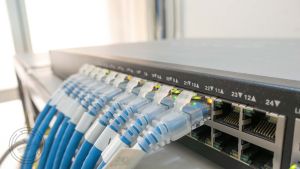It’s easy for us to take technology for granted. in situations and working from home means that in many cases you are expected to provide your own technical support. Many people have contacted me over the past few weeks with issues involving their home networks. I thought I would try to explain how what and why things work the way they do so and provide some useful tips on how to keep your network functioning correctly.
Some of this information may seem obvious, however, if you’re not a technologist it may help you overcome some hurdles.
The Internet and Cloud Services
The technology we are currently relying on is not infinite. Networks and cloud storage services are built around peak amounts of traffic, which is also known as the ‘busy hour’. For businesses, this is spread across the workday, and typically 9 am is usually the busiest time. For the people at home, the busy hour tends to be around 9 pm.
So, the network and applications are there for us all to use in-between times, but as more people work from home and new communities and organizations like schools start to teach at home, network speeds may become an issue. For example, schools using online learning will change the amount and time of usage given that each device in an online lesson requires around 3 Mbps. Two kids, two lessons = 6 Mbps.
We work with our Service Provider partners to continually reviewing network performance to ensure there is enough for everyone and it’s being provided in the right places, but we need to remember that networks are not infinite.
Think of the network like big water main running through our towns and down our streets, if everyone turns on the taps at the same time, the pressure drops, and the water frustratingly dribbles! The same goes for the network.
Clouds are built on a massive scale and span a myriad of use cases. Many business users will recognize Office365 as a cloud service, but Netflix and Amazon Prime Video are also based in the cloud. Thus, cloud services experience these busy hours where capacity is needed. However, the difference between these services and your network is that, when deploying into the cloud, an application owner commits to a certain amount of usage with the ability to burst if need be. If the application hits that upper burst limit its performance may degrade until the limit is raised.
In many applications, we have two types of data: control and user. User data is the actual information associated with the user’s application.
And if we consider a video conference from home, the control data is the data that the application (usually in the cloud) uses to set the call-up. The amount of data is quite small, but the volume is high.
At 9 am, when your world is starting its virtual workday, this control traffic can peak, causing the users to experience to drop leading to frustration, thus limiting productivity. This applies to lots of applications such as remote working VPN’s, sales management tools, and remote authentication to name a few.
That’s why a sign in or call set up can take a long time at these times.
To avoid connection delays, set your conference calls to start at an irregular time,
like 5:10pm as opposed to 5pm.
Once the connection is established, the network should have the capability to deliver it.
It’s also worth noting that whilst not considered cloud services mobile networks follow the same principles. Have you ever had that annoying “beep – beep – beep” when trying to dial out on your mobile? That’s because there is no capacity in the control network to connect you. Essentially you can’t get a line.
Working at Home
Many of us take our home network for granted, for the most part, it just works, but as more of us are in the home we are vying for the same resources. We need to accept that the most “broadband” connection to the home is asymmetric. That means it’s fast one way and not so fast the other. For example, I have 26Mbps in my home (download) and 5Mbps out of my home (upload).
If you want to find your home connection speed, use a speed checker.
Additionally, residential broadband services tend to contend. This means service providers rely on the fact we don’t all hit send at the same time, and if we do then we may only get a few Kbps as oppose to the Mbps we know and love. In reality, this never happens but the more people who are online, the more the available bandwidth needs to be shared.
A decent quality video conference only needs around 3Mbps, so, if both my wife and I are working we are going to be struggling to get our 6 Mbps of video through the 5 Mbps up-link. Add to that the kids doing online lessons at another 3 Mbps and it could be quite messy!
See if you can reduce the quality of the video or turn the video off at busy times.
Your home WiFi is going to take a bit of a hammering. Firstly, make sure the Hub is located relatively centrally in the house with nothing directly around it to block the signal. Ensure it hasn’t fallen down the back of the phone table and is not positioned in a place like the TV cabinet as the TV is full of metal which will weaken the signal.
Maybe also consider a powerline extender or repeater to push the signal to those more remote parts of the house.
If you have a sophisticated enough hub or a WiFi access point you can set up a work WiFi Service Set Identifier (SSID) and protect it by limiting bandwidth for non-essential applications like YouTube or streaming services during the workday. I do this really well in my house and no one has ever complained.
Get a decent headset
I’m a recovering audiophile, so I can sometimes be a bit of a purist. However, when you plug your standard headphones into your laptop, they may not use the microphone that’s built-in. You may well be using the mic on the laptop itself which is designed to pick up sound from all around. A decent headset will have directional and background noise suppressing mic. It will help the sanity of you and your colleagues.
Were all in this together. For those of you who are new to this home working gig and are finding it frustrating and uncomfortable, I hope this blog helps you understand why you are experiencing some of these network issues and provides you with some ways to overcome them.
Source: blogs.cisco.com Credit@ Dominic Elliott











